
Please install a more recent version of your browser.
26 November 2021
8 minutes read
pictures © Fille Roelants
Although Belgian fashion professionals designers have played a significant role in the industry since the late 1980s, there has never been a local fashion week. Antwerp makes up, to a point, with Fashion Talks, a lively biennial conference that is organized along with the Belgian Fashion Awards ceremony.
Yesterday’s fifth edition was held at the neo-gothic, recently renovated Handelsbeurs, the world’s oldest stock market. Fashion Talks, which is organized by non-profit Flanders DC, unites local and international industry leaders, this time including designers Pieter Mulier, Jan-Jan Van Essche and Vanessa Bruno. Major BFA’s went to Walter Van Beirendonck (Jury Prize, a career-crowning honour), Courrèges creative director Nicolas de Felice (Designer of the Year), and Meryll Rogge (Emerging Talent of the Year). Around 600 people attended, in a slightly reduced configuration allowing for more social distancing.
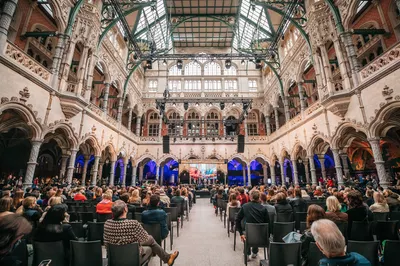
Fashion Talks at Antwerp's Handelsbeurs
Clare Press, presenter of the Wardrobe Crisis, a sustainability-themed podcast, remained in Sydney to give the day’s opening talk. “I did actually think about coming, but to fly around the world to talk about sustainability, well, it's a bit problematic, isn't it?” Press focused on the flaws of the fashion system and how to fix them. “Who knows what tomorrow will bring? We can't predict the future, but we can decide who we want to be and what we want to stand for.”
“At the heart of this is creativity. We're so good at reinvention. We can come up with a new design every season, or every week. And yet, when you pull back and you look at the fashion system in which we operate and do these things, it doesn't evolve. The fundamental ways that we make, sell, distribute, and consume clothing have not changed in years.”
Top of the bill at Fashion Talks was Pieter Mulier, creative director at Alaïa. Mulier, who worked with Raf Simons for over 15 years, at the designer’s own brand as well as at Jil Sander, Dior and Calvin Klein, compared the Alaïa job to winning the lottery. “To be offered that job, for a house that important, from the position I was in before as the right hand of somebody very important, and at a point where I had almost decided not to work in fashion anymore, was unexpected. To be able to work for a house where the name hasn’t been burned, and where the level has been kept high, that’s a true luxury.”
Alaïa is a relatively small house, a legendary name within the fashion community, but not necessarily that well known to a broader audience. “My sister said, congratulations, but I’ve never heard of that brand.” Which made Mulier think about how to translate Alaïa, and his 45 year body of work, to people who have never heard of him, or who have only seen his clothes on pictures.
“I don’t think I’m important in the story. It’s about Alaïa, it’s about him. It’s a big job, but it’s also a very small job.”
Pieters offered this take on sustainability: “Alaïa would never erase the past, he always made things better. A skirt from 1981 would come back in 1984: the same skirt, only improved. In luxury, you can’t get more sustainable. Also, it’s difficult to find vintage pieces. People keep their Alaïas.”
“I can’t get into much detail about my previous experience at Calvin Klein. We felt like we were living the American dream. But when you shoot for the stars, you also fall from the stars, and we fell in a big way. At Calvin, we designed 16 collections a year, and I got disgusted by the amount of product we had to vomit. At some point I started asking myself, who buys this? And I still don’t know. At Alaïa, I don’t have to ask myself that question.”
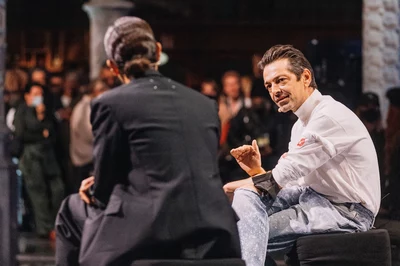
Pieter Mulier
In her opening statement, Clare Press evoked the open letter to the fashion industry that made global headlines in May of 2020. The manifesto came out of a series of Zoom meetings led by, among a few others, Belgian designer Dries Van Noten, who saw an opportunity in the pandemic for fundamental changes to the system, making it more environmentally and socially sustainable. “Now fast forward,” said Press, “and it's hard to say how far things have progressed.”
In a round table discussion on overconsumption led by Vestoj magazine founder Anja Aronowsky Cronberg, designer Jan-Jan Van Essche talked about signing the letter last year. “I found it important to help along this movement”, said Van Essche, who recently celebrated the tenth anniversary of his own line and is a co-owner of Atelier Solarshop in Antwerp. “But at the same time, the pamphlet affirmed to me that our way of working wasn’t wrong. It felt like it was a start: we would co-sign the manifesto and then see what else we could and should improve on.”
“I’ve had doubts about the system for a long time,” added Paris-based designer Vanessa Bruno. “I’ve been doing collections for more than 25 years. I believe in pieces that you can wear time and again. At some point I decided to move back from four collections a year, not counting capsules, and to focus instead on two collections, and I’d make them smaller. It changed the rhythm of my business, but the business is still there. It is possible to change.”
Aronowsky Cronberg saw a difference between small changes and systemic ones. “Slowing down the pace, moving to two collections instead of four, is a change that can be very readily integrated in the system that is already in place.’ In the end, we still think of fashion as something that becomes passé and has to be renewed. Last season’s stuff is still less relevant than this season’s fashions.”
But who should implement change? Is it a task for businesses, or for governments? “Both,” said Van Essche. ‘For myself, I think I do reasonably well. But I'm at a point where I feel it’s not enough. I keep trying to find ways to change the system. It’s something that I think about daily. And I believe that it’s time to have these debates, to think everything through again.”
For Vanessa Bruno, “Change has to come from the industry. Small groups are already leading the way. It’s the big groups that need to change. We live in a democracy, and I prefer people reacting rather than having people above us dictating us what to do. I think that the more people know about their clothes, where they come from and how they’re made, the more easily they will change their ways.”
“Aren’t we letting the system off the hook?” wondered Aronowsky Cronberg. “We all recycle. We separate plastic and glass. But I wonder if that's not just a distraction. It’s nothing compared to what can happen when a government decides to implement change.”
“We can be a part of the solution,’ said Bruno, ‘but I firmly believe that you have to let the mind and the spirit go free. Creativity comes first.”
Added Van Essche: “Staying close to your core identity is a good start, but I still think we need more. At the beginning of the pandemic there was a lot of potential for change, but that energy has already slowed down.”
Asked what they would like to see changed in the fashion system, Bruno and Van Essche agreed. They would both like to see more factories in Europe. “I wish that, in France, we could build up again what we lost many years ago. We used to have wonderful knitwear factories, lace factories. Very few have survived, and only couture brands can afford to work with them.”
“What is the sense of manufacturing further and further away?” said Van Essche. “I find the relationships with the people who make the stuff that we design very important. There is a wealth of knowledge that is going away. We should encourage young people to become artisans and to take pride in their work.”
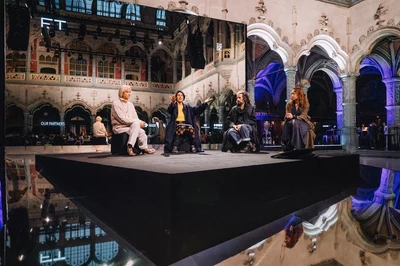
Vanessa Bruno, Anja Aronowsky Cronberg, Jan-Jan Van Essche, Laura Larbalestier
Elsewhere on a smaller stage in the ornate Handelsbeurs building, model Hannelore Knuts talked about raising awareness about the working conditions for models. It was her first talk ever.
She titled her lecture ‘Growing Up In Fashion’, which to her and countless other models meant growing up in public, being judged and compared to other models constantly. “I was taught to be a good girl, to do as they ask. Overtime, I became a stranger to myself. I felt like a body without a human inside.” Knuts, who in her long career has worked for anyone from Chanel to Gucci, evoked abusive casting agents and designers, chronic stress, and questionable finances. “As a model, you need to stay loyal without any guarantees. Once, I had to say no to a non-paid job for personal reasons. I never got booked by this person again. Nobody says no in fashion, not even for a funeral.”
Knuts has evolved. “If the system says jump, I’ll still jump, but I’ll decide how high.”
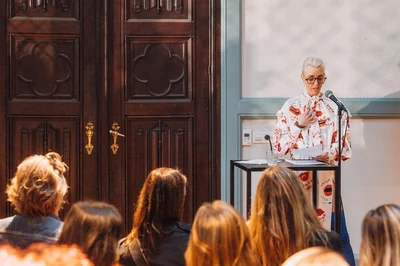
Hannelore Knuts
Other speakers at Fashion Talks included Canadian ‘retail guru’ Doug Stephens who positioned that stores have become media. ‘The store is no longer where the retailer says it is. The store can be anywhere, whether it’s your phone or a physical place.’
“Consumers are looking for trust and authority. Knowledge is no longer good enough. In fact, most consumers believe they have more knowledge than the sales associates that are working in a store. Instead, they want expertise.” Knowledge, said Stephens, is what you learn from reading about a product in a manual. Expertise means having used the product you’re selling. “People want to talk to people who have experience with the products they’re interested in.”
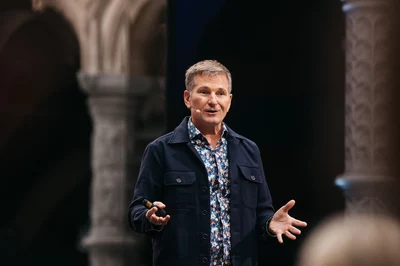
Doug Stephens
Bertony Da Silva of burgeoning streetwear brand Arte Antwerp explained how as a student he used to travel to London, Paris or Amsterdam and that the stores in those cities represented what was going on in the streets. “Antwerp had always been known for high fashion, but no-one was doing streetwear. I had friends who were musicians, deejays, creatives and I thought that maybe we should create something in Belgium. We would have to be the ones doing it.”
Da Silva began Arte Antwerp circa 2009 with a line of t-shirts. It became a fully-fledged brand about 5 years ago. “I didn’t know where to find good manufacturers, so I said, you know what, I’ll just book a ticket to Portugal and find them myself. I went around Lisbon and just asked people, Where can I get quality product? They said, you should go to the north, so I booked a train ticket. When you keep knocking at doors, at some point you meet people. I don’t look at the problem, I look at the solution.”
Arte Antwerp now has stores in Antwerp and Brussels and over 200 doors worldwide, including a recent pop-up at Printemps de l’Homme in Paris.

Bertony Da Silva
“I love streetwear when it’s done in an honest way,” said Alaïa’s Pieter Mulier during his talk. “Even if it’s by a luxury brand, and the sneakers sell at 700 euro. But if they do streetwear just because it sells, that’s ridiculous. When I arrived at Alaïa, I said, I don’t want to do sneakers, logos, hoodies, and they said, praise the lord, because we don’t want that either.”
Cookies saved